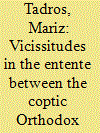| Srl | Item |
| 1 |
ID:
084069


|
|
|
|
|
| Publication |
2008.
|
| Summary/Abstract |
This article claims that all of the objectives put forth by the Egyptian revolutionary regime appeared in the leftist journal al-Fajr al-Jadid several years prior to the July 1952 revolution. The authors' central claim is also that the essentials of Nasserism including its basic tenets neutralism, pan-Arabism, and Arab socialism were clearly articulated in al-Fajr al-Jadid. Although there is no clear-cut evidence to show the existence of neither political nor ideological direct links between Nasser and the al-Fajr al-Jadid's group, this article clearly demonstrates the existence of remarkable ideological textual similarities between Nasserite's and al-Fajr al-Jadid's revolutionary ideas.
|
|
|
|
|
|
|
|
|
|
|
|
|
|
|
|
| 2 |
ID:
133302


|
|
|
|
|
| Publication |
2014.
|
| Summary/Abstract |
The article is a case study of work organization at the Services d'Egypte of the Suez Canal Company from the outbreak of World War II to the company's nationalization in 1956. In this multinational and multicultural workplace, organizational hierarchies and division of labor were traditionally defined according to "national" identities, while maintaining a strict segregation between européens and indigènes, to use the company's terminology. Starting in the 1930s, the company faced new measures of economic nationalism imposed by the Egyptian government, including required quotas of Egyptian personnel. These measures progressively redefined the political boundaries of the company's action in the management of its workforce. Using unpublished archival documents from the company's personnel files, this article analyzes the processes of feminization and Egyptianization of the company's office workers during World War II and the 1950s. The process was driven by a precise organizational strategy, based on both "racial" and "gender" criteria, which aimed to redefine the company's internal hierarchies and to keep management and decision making in the hands of the "Europeans," while complying with the terms of the conventions of 1937 and 1949 that regulated the relationship between the company and the Egyptian government.
|
|
|
|
|
|
|
|
|
|
|
|
|
|
|
|
| 3 |
ID:
090393


|
|
|
|
|
| Publication |
2009.
|
| Summary/Abstract |
Although some contemporary Egyptian studies have broached aspects of the relationship between the Coptic Orthodox Church and the regime, few have examined developments in the political rapport between the two in the last decade. Important studies have touched on the relationship between the state and church during Nasser's regime, the Sadat years, and the early years of the Mubarak regime, up to the first half of the 1990s. However, there is a paucity of literature on the relationship between the Coptic church and the Egyptian state in the past ten years, a lacuna that this study addresses.
|
|
|
|
|
|
|
|
|
|
|
|
|
|
|
|